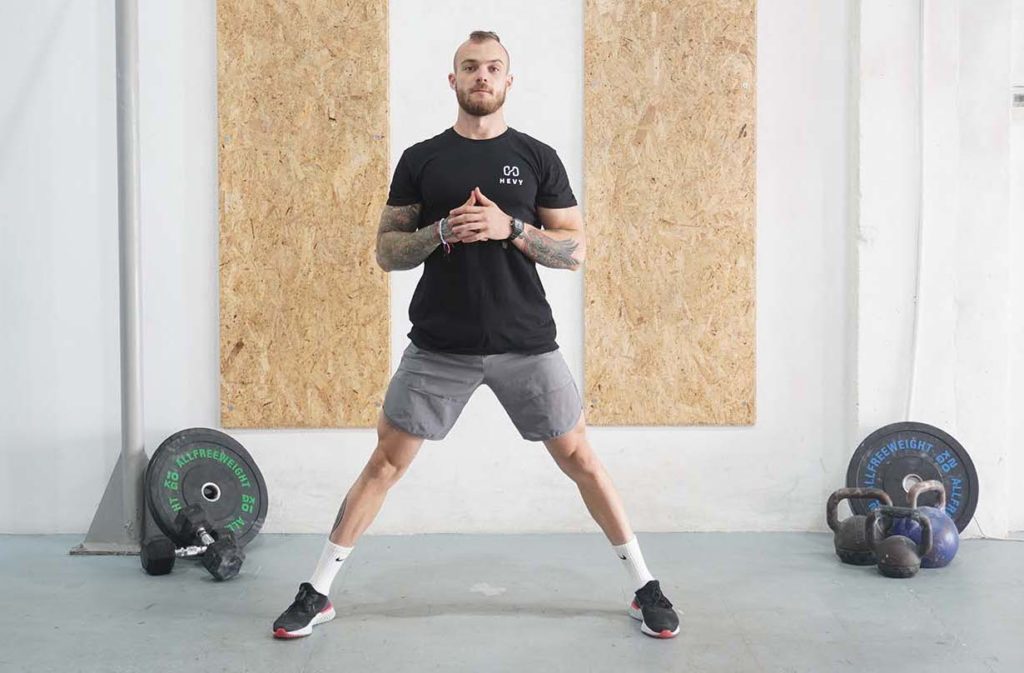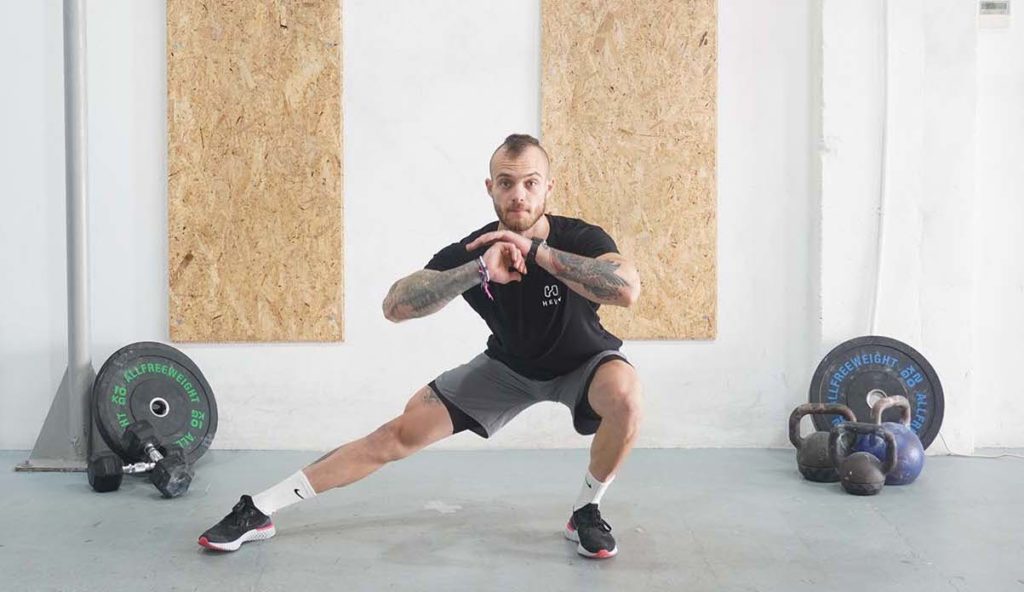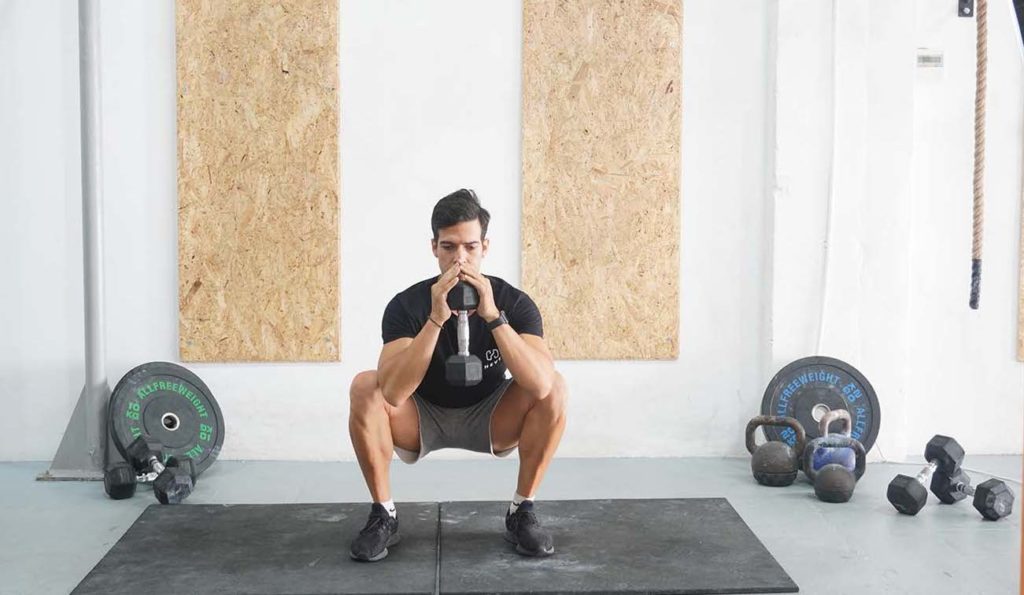Why are lateral squats beneficial?
Lateral squats are one of the most underrated exercises for the lower body. The movement is fantastic because it emphasizes our posterior chain, trains our inner thigh muscles, and works our quadriceps (1).
Unlike most lower body exercises, lateral squats are also beneficial for pointing out weaknesses and forcing us to fix them. For example, many people avoid training their inner thigh muscles, which can create issues down the road. Lateral squats force you to evaluate your adductor strength and diagnose a weakness even with lighter weights.
Lateral squats are also fantastic for improving posterior chain activation because our glutes and hamstrings have to work extra hard to produce the force we need to do each repetition. The room for error is much smaller, and we can’t rely on our strong quadriceps to save us.
How to do a Lateral Squat
- Start with the bodyweight lateral squat by having your feet together. You can have your toes pointing slightly out for comfort as you descend.
- Have your arms to your sides, bring your shoulders back, engage your abs, and direct your gaze forward.
- Take a breath and bring your right leg to the side as you shift your weight in that direction, making sure your heel is in firm contact with the floor. As you shift to the right, ensure that your left foot remains on the floor and doesn’t rotate out.
- Descend to the right as much as your leg strength, adductor flexibility, and hip mobility allow. Ideally, you should go down until your thigh is parallel to the floor, but you can squat higher at first.
- Push through your right heel to squat up and bring your right leg into the starting position. As you go back to the top, exhale and prepare for the next repetition.
- Inhale and bring your left leg to the side, descending as much as you can.
- Keep alternating between left and right, breathing regularly.
What muscles do lateral squats activate?
The most notable muscle group involved in lateral squats is the quadricep – the large front thigh muscle group (1). The quadriceps are responsible for knee extension, which means it works hard as you go down and back up (2).
Your adductors (inner thigh muscles) are also heavily involved during lateral squats (1). The adductor’s primary job is to bring your leg in from the side. As you squat up, the adductor becomes more active to contribute. Your adductor also continues to work as you go back to the starting position.

Lateral squats activate the gluteus medius – the buttocks muscle that plays a vital role in lateral movement. The glute medius muscle is positioned laterally and connects the pelvis to the femur (large thigh bone). Thanks to its position, the gluteus medius is the primary muscle responsible for hip abduction – moving your leg away from the midline of your body (3).
Beyond that, our hamstrings are somewhat involved during lateral squats. The muscle group has three heads that connect the hip to the tibia (shinbone). The hamstrings’ primary functions revolve around knee flexion, but the muscle is also involved in hip extension.
What is the difference between a cossack squat and a lateral squat?
At first glance, Cossack and lateral squats seem identical. But there are differences between the two exercises that make them unique.
The primary difference between Cossack and lateral squats is the overall execution. With Cossack squats, you assume a wide stationary position and shift your weight from one side to the other. With lateral squats, you approach the execution like you would an alternating lunge exercise. Instead of assuming a stationary position and shifting from left to right, you bring one leg to the side, do the repetition, then bring it back in.
The second difference between the two exercises relates to foot position. Specifically, as you do Cossack squats and load one side, your opposite foot goes off the floor and points to the side. Doing so allows you to emphasize the loaded side better and increase the range of motion, allowing you to squat deeper. In contrast, both of your feet remain planted during each lateral lunge repetition.
The final significant difference relates to torso angle. Since you’re squatting deeper on Cossack squats, your torso naturally leans forward more. In contrast, your torso remains more upright during a standard lateral squat.
Variations and Modifications of the Lateral Squat
1. Weighted Lateral Squat
If the bodyweight lateral squat feels too easy, you can always increase the difficulty by adding weight to the equation. One option is to place a barbell on your back. Alternatively, hold a dumbbell or kettlebell in front of your chest, similar to a goblet squat.
2. Lateral Squat Walk
Lateral squat walks are a nice variation that makes the exercise more engaging to do. Instead of alternating between left and right, only go in one direction. For example, step to the right, squat down, and come back up. Bring your left leg to the right, step to the right again, and repeat. Once finished, do the same number of steps in the opposite direction.
3. Lateral Box Step-Up
Instead of squatting to the side, place a plyo box or gym bench next to yourself, step on it, and go up. This movement is excellent for engaging your gluteus maximus better.
Mistakes to Avoid
A common mistake to avoid when doing lateral squats is turning the movement into a Cossack squat. In their effort to reach a greater depth, trainees lift their free foot off the floor, which allows for a greater range of motion. When doing a lateral squat, keep both feet on the floor at all times.
Another common mistake is using too much resistance for lateral squats. In doing so, you limit your ability to move gracefully from side to side, and your range of motion takes a hit. Begin with bodyweight lateral squats and gradually increase the resistance. That way, you will feel decently challenged but not to the point where you have to sacrifice your technique.
The third common mistake to be mindful of is rounding the lower back. To assume the correct lateral squat position, many trainees forget about their torso. As a result, they might lean forward, which often leads to a rounded lower back. Avoid this mistake by being conscious of your upper body just as you pay attention to your legs and feet. Keep your chest out and avoid leaning forward as you descend into a squat.
Similar Exercises to Lateral Squats
Cossack Squat

As mentioned earlier, Cossack squats carry many similarities to lateral squats. Both movements have you squat to the side, allowing you to emphasize the same muscle groups. Cossack and lateral squats also have a similar range of motion and overloading potential.
The primary difference is that Cossack squats are more of a functional movement. You have to work hard to maintain balance, the range of motion is slightly longer, and you stretch your inner thigh muscles better.
Lunge (Dumbbell)
Dumbbell lunges are similar to lateral squats as far as execution goes. You step forward, squat down to complete a repetition, return to the top, and bring your leg in. You then step forward with your other leg and repeat the movement. The two are essentially the same exercise, with the only difference being the direction of the squat. As a result, lunges and lateral squats train many of the same muscles with the same load and through the same range of motion.
Goblet Squat

Goblet squats are a simple and effective squat variation that builds your lower body, even if you have nothing but a dumbbell available. The movement is similar to lateral squats because both train your quadriceps, hamstrings, and glutes.
